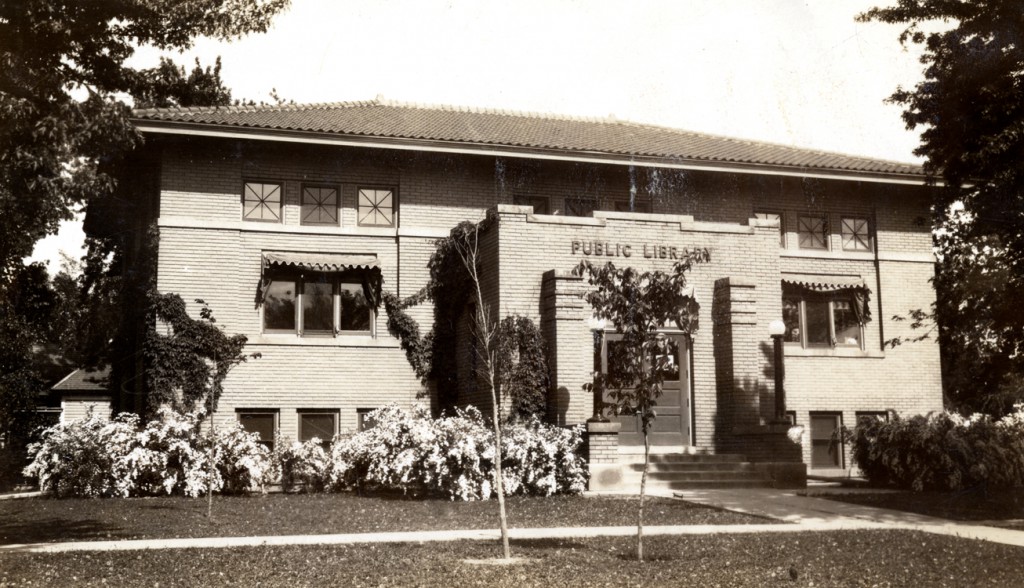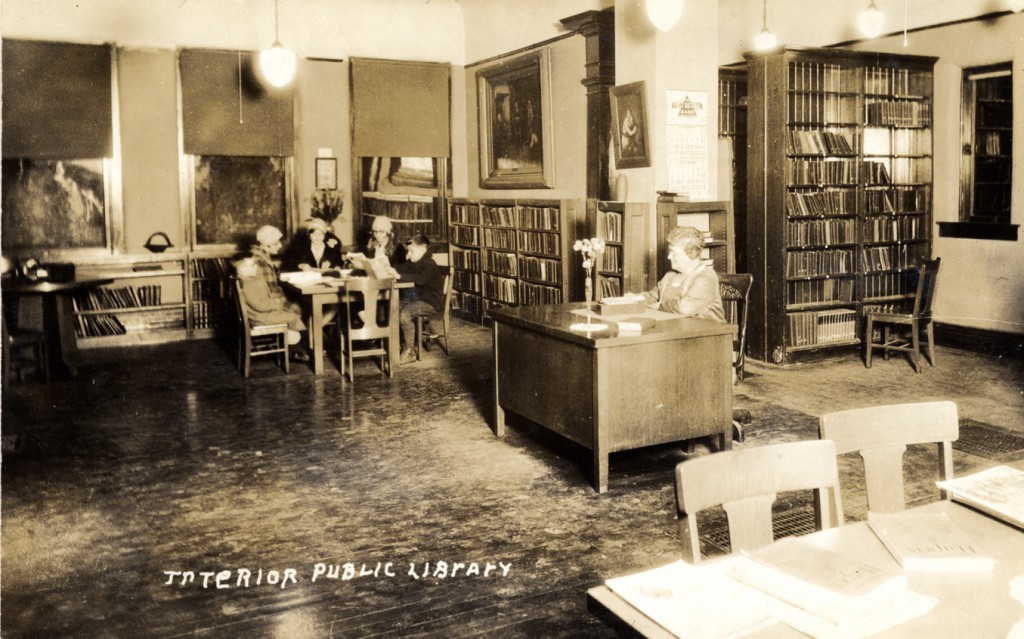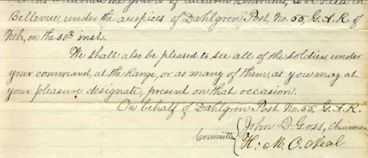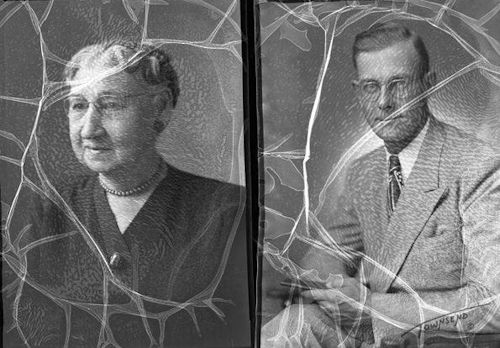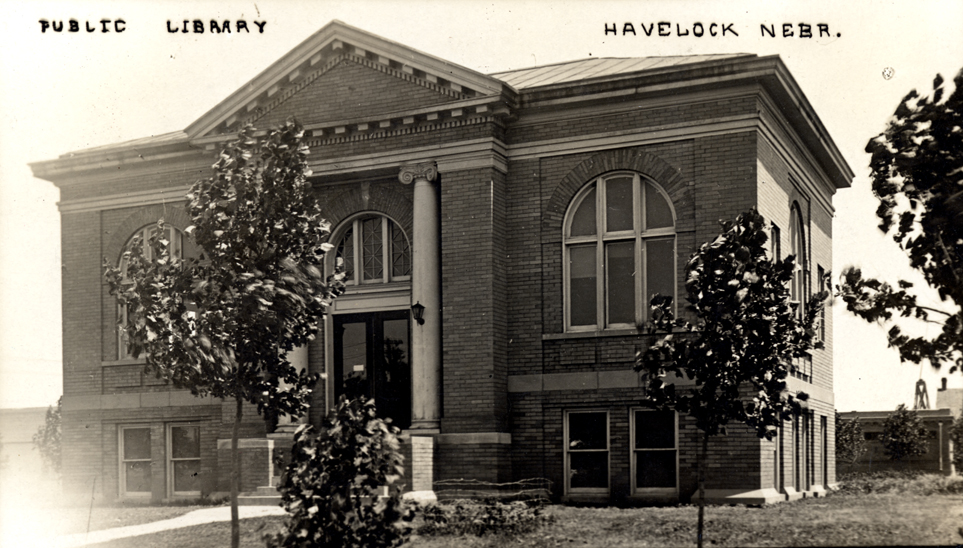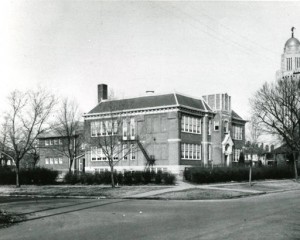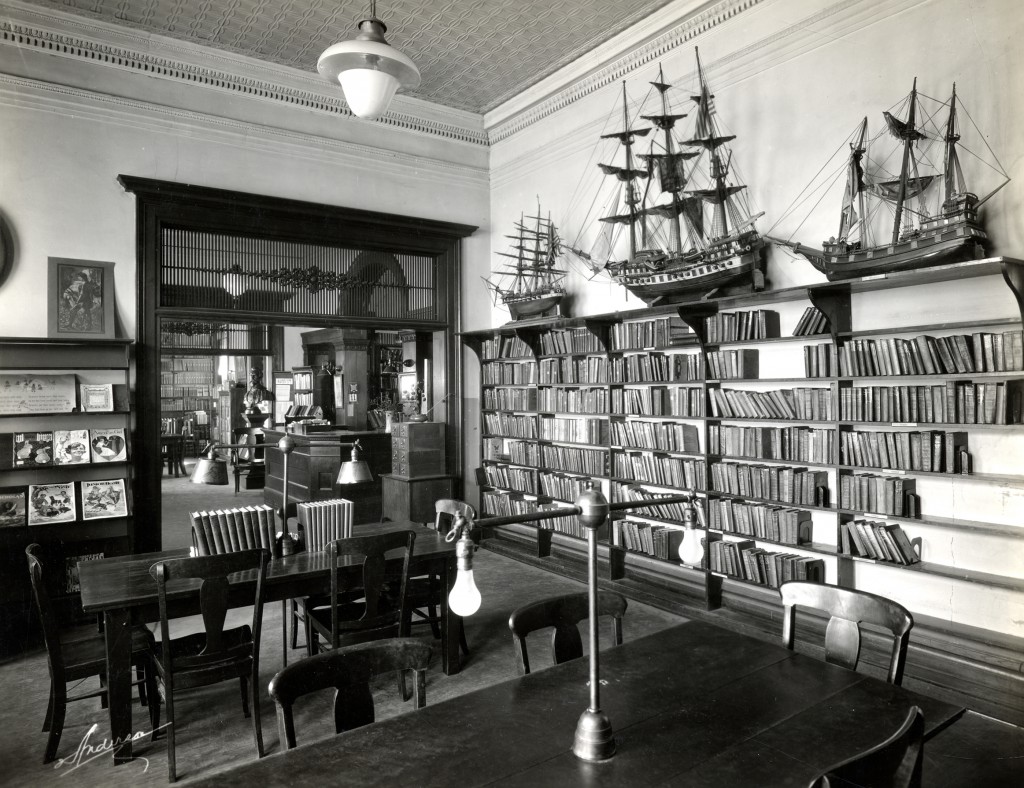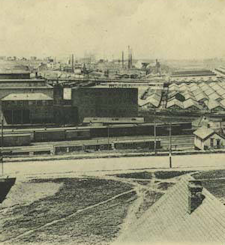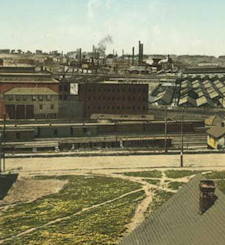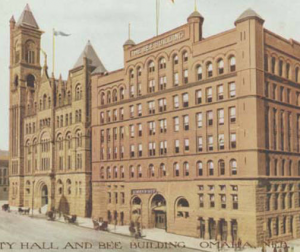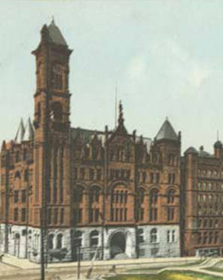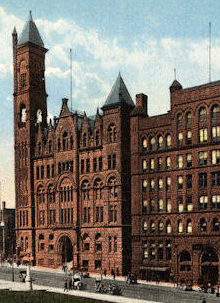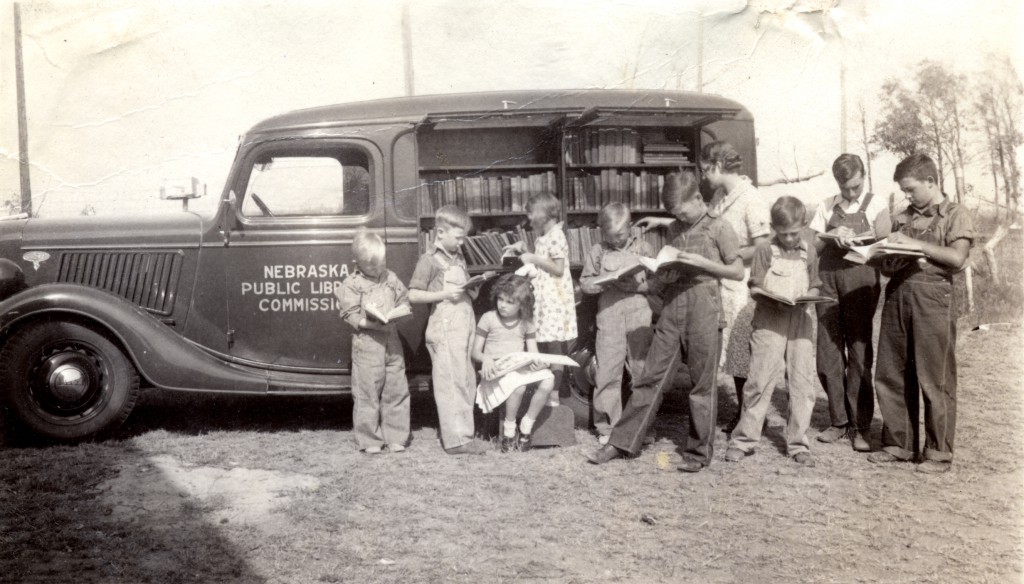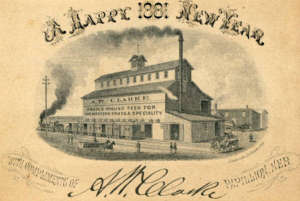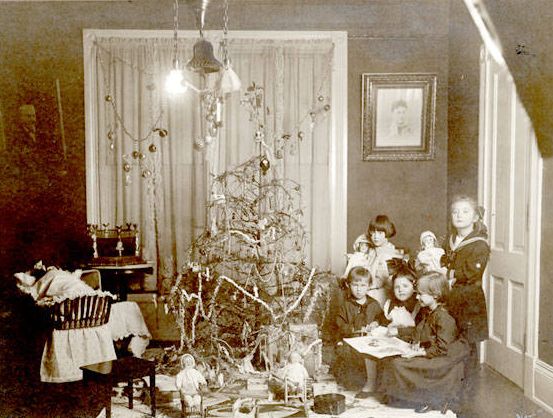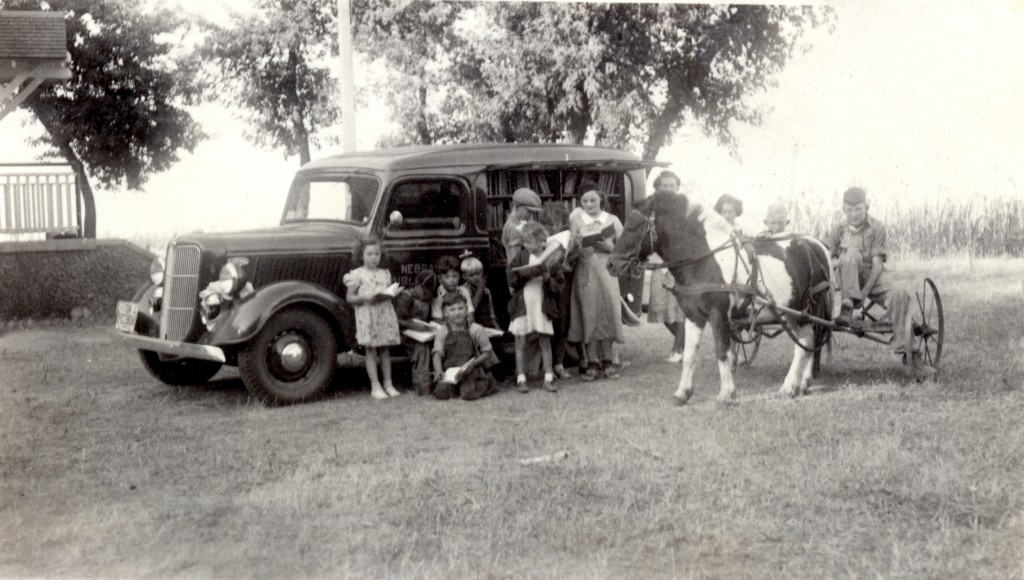Search the Blog
Categories
- Books & Reading
- Broadband Buzz
- Census
- Education & Training
- General
- Grants
- Information Resources
- Library Management
- Nebraska Center for the Book
- Nebraska Libraries on the Web
- Nebraska Memories
- Now hiring @ your library
- Preservation
- Pretty Sweet Tech
- Programming
- Public Library Boards of Trustees
- Public Relations
- Talking Book & Braille Service (TBBS)
- Technology
- Uncategorized
- What's Up Doc / Govdocs
- Youth Services
Archives
Subscribe
Category Archives: Nebraska Memories
Throwback Thursday: Interior photo of the Albion Nebraska Carnegie Library
Posted in General, Nebraska Memories
Leave a comment
Just Like Riding a Bike
You may not have realized that May is National Bike Month, though I suppose it makes sense to get out and enjoy the spring weather on your bicycle. The first verifiable invention of the bicycle occurred in the 1800s, and as a glance through Nebraska Memories shows, Nebraskans have been enjoying their bikes for many years.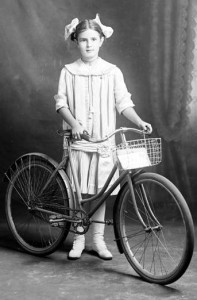
The Butler County Gallery Collection includes some portraits of children posed with their bicycles, such as Elvannah Brown. While she is technically riding a tricycle, rather than a bicycle, this image of toddler Nettie Butler 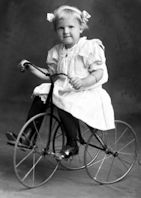 was too adorable not to include.
was too adorable not to include.
The Townsend Studio Collection also includes some portraits of people with their bikes. This portrait of Mrs. Tomas Bennett most likely depicts a bicycle used for purely recreational purposes, while Ed Mockett’s portrait depicts a cyclist and his racing bike.
A less formal, and more recent, depiction of a bicycle is shown in this image of children at 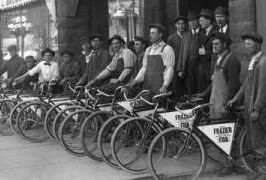 the Nebraska Children’s Home in Omaha receiving a bike, among other gifts, in 1938. Also of interest is a group of images of the Frazier Cycle Company in Omaha in the early 1900s.
the Nebraska Children’s Home in Omaha receiving a bike, among other gifts, in 1938. Also of interest is a group of images of the Frazier Cycle Company in Omaha in the early 1900s.
Visit Nebraska Memories to search for or browse through many more historical images digitized from photographs, negatives, postcards, maps, lantern slides, books and other materials.
Nebraska Memories is a cooperative project to digitize Nebraska-related historical and cultural heritage materials and make them available to researchers of all ages via the Internet. Nebraska Memories is brought to you by the Nebraska Library Commission. If your institution is interested in participating in Nebraska Memories, see http://nlc.nebraska.gov/nebraskamemories/participation.aspx for more information, or contact Devra Dragos, Technology & Access Services Director.
Posted in Nebraska Memories
Leave a comment
Preserving Nebraska’s Past
Are your paper archives crumbling? Are your photographs fading? Now may be the time to plan for preservation, and digitization is one of the best ways to preserve your historical materials.
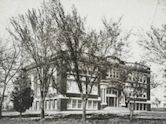 Digital versions of items provide access to content while limiting the handling of delicate materials. The lantern slide of the Van Fleet Teachers College (Nebraska Wesleyan University Collection) to the left has a crack down the right side which, while not readily obvious in the digital image, could become worse if the slide is handled regularly. The 1887 Letter from John Q. Goss and H.M. O’Neal to Major Butler (Sarpy County Historical Museum Collection) below has creases from folds that could eventually crack or tear.
Digital versions of items provide access to content while limiting the handling of delicate materials. The lantern slide of the Van Fleet Teachers College (Nebraska Wesleyan University Collection) to the left has a crack down the right side which, while not readily obvious in the digital image, could become worse if the slide is handled regularly. The 1887 Letter from John Q. Goss and H.M. O’Neal to Major Butler (Sarpy County Historical Museum Collection) below has creases from folds that could eventually crack or tear.
Some items may disintegrate for other reasons such as chemical reactions within the structure of the material or a poor storage environment. The acetate negative of Lena Carveth and Ernest F. Carveth (Townsend Studio Collection) below is an example of deterioration due to a chemical reaction. Nitrate negatives are even more unstable; as the chemicals in the negatives decay, they become highly flammable and require very specific storage conditions. Before these items disappear forever, consider scanning them according to archival standards.
If you are wondering where to start with preservation, check out the Nebraska Library Commission’s Preservation of Library Materials list of resources. You will find guidelines and tips on the care and preservation of many different types of materials. And remember, if you do plan to digitize any materials, Nebraska Memories hosts Nebraska-related materials for web access and Library Commission staff may be contacted for consultation.
Nebraska Memories is a cooperative project to digitize Nebraska-related historical and cultural heritage materials and make them available to researchers of all ages via the Internet. Nebraska Memories is brought to you by the Nebraska Library Commission. If your institution is interested in participating in Nebraska Memories, see http://nlc.nebraska.gov/nebraskamemories/participation.aspx for more information, or contact Devra Dragos, Technology & Access Services Director.
Posted in Nebraska Memories
Leave a comment
Thanks for the Memory
With my retirement near, I decided to devote my last Nebraska Memories blog posting to reminiscing about some of the visits I made to organizations that are participating in Nebraska Memories. 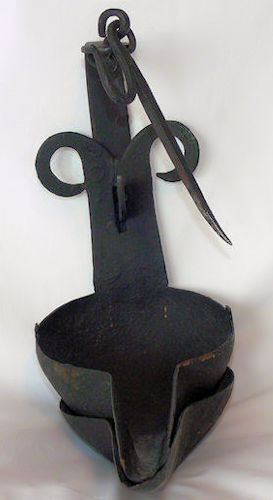 In 2008 I visited the Bess Streeter Aldrich House & Museum with Devra Dragos and Lori Sailors. We toured the home that Bess and her family lived in, and saw memorabilia and documents related to her writing. I remember seeing her writing desk, typewriter, the original typed manuscript of A Lantern in Her Hand, and the Mutton Tallow Lantern that Bess’s mother and her family carried with them on their journey to Iowa were on display. Lori and Devra returned later to take photographs.
In 2008 I visited the Bess Streeter Aldrich House & Museum with Devra Dragos and Lori Sailors. We toured the home that Bess and her family lived in, and saw memorabilia and documents related to her writing. I remember seeing her writing desk, typewriter, the original typed manuscript of A Lantern in Her Hand, and the Mutton Tallow Lantern that Bess’s mother and her family carried with them on their journey to Iowa were on display. Lori and Devra returned later to take photographs.
Also in 2008, Lori and I visited Wanda Marget at Fairmont Public Library, who gave us a great tour of the Fillmore County Museum, located in a building donated by the Ashby family. One room featured a restoration of Dr. Ashby’s medical clinic, including the appendix of one of his patients preserved in a jar! Another room featured many photographs and documents related to the Fairmont Army Airfield during World War II. In 1944 Lt. Colonel Paul Tibbets came to the Airfield and picked several crews and their support personnel for a secret mission – the atomic bomb dropped o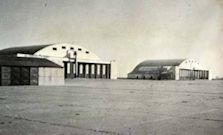 n Hiroshima. The crews were taken from the Airfield in the middle of the night for training. The Fillmore County Historical Society also owns the old drug store building, complete with the original soda fountain. Lori returned to scan the items now in the Fairmont Public Library — Fillmore County Historical Society collection.
n Hiroshima. The crews were taken from the Airfield in the middle of the night for training. The Fillmore County Historical Society also owns the old drug store building, complete with the original soda fountain. Lori returned to scan the items now in the Fairmont Public Library — Fillmore County Historical Society collection.
The Durham Museum in Omaha is a fascinating place. The restored train station housing the museum is spectacular. I remember the stunning interior with a beautifully tiled floor, a functioning soda fountain, and an entire restored railroad car in the lower level. It is a popular event venue – several years later I attended a wedding there. The Museum owns a large photograph collection. Devra and I visited the Museum in late 2008. The Museum scanned and contributed images from the William Wentworth photography studio collection to Nebraska Memories. This 1939 photograph of a 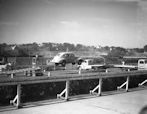 Car jumping flatbed trucks is a great example of the commercial work Wentworth did for business clients.
Car jumping flatbed trucks is a great example of the commercial work Wentworth did for business clients.
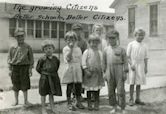 In 2009 Lori and I visited Lincoln Public Schools to see their collection of historical photographs. Lori returned later to scan some of them. We were delighted to add the images to Nebraska Memories, and later very thankful that we could provide them with copies of their images after the LPS building was mostly destroyed by fire on May 30, 2011. I find this photograph of Students at Hayward School rather poignant. At the top are the words “The growing Citizens Better schools, Better Citizens”. The three boys and one of the girls are barefoot. Were they too poor to have shoes? Were they recent immigrants?
In 2009 Lori and I visited Lincoln Public Schools to see their collection of historical photographs. Lori returned later to scan some of them. We were delighted to add the images to Nebraska Memories, and later very thankful that we could provide them with copies of their images after the LPS building was mostly destroyed by fire on May 30, 2011. I find this photograph of Students at Hayward School rather poignant. At the top are the words “The growing Citizens Better schools, Better Citizens”. The three boys and one of the girls are barefoot. Were they too poor to have shoes? Were they recent immigrants?
 Another collection featuring photographs of children is from the Nebraska Children’s Home Society in Omaha. The Society became a particpant after Lori and I visited in 2010. Lori scanned photographs, brochures and newsletters that the Society used to raise funds for care of the children and to ecourage adoptions. The children in this photograph of an Easter Egg Hunt on the grounds of the Home look like they are having a great time.
Another collection featuring photographs of children is from the Nebraska Children’s Home Society in Omaha. The Society became a particpant after Lori and I visited in 2010. Lori scanned photographs, brochures and newsletters that the Society used to raise funds for care of the children and to ecourage adoptions. The children in this photograph of an Easter Egg Hunt on the grounds of the Home look like they are having a great time.
 Another 2010 visit was to the Union College, Ella Johnson Crandall Memorial Library with Devra, to see photographs in the College archives. The collection consists primarily of photographs of students and buildings on the College campus. There are also some photographs of the College View neighborhood, including this one of the Lincoln Traction Company streetcar on College Avenue. Evidently streetcars occasionally got a little too close for comfort. In 1910, a streetcar ran off the track and pushed the College View bandstand at the corner of 48th and Prescott Streets off its foundation!
Another 2010 visit was to the Union College, Ella Johnson Crandall Memorial Library with Devra, to see photographs in the College archives. The collection consists primarily of photographs of students and buildings on the College campus. There are also some photographs of the College View neighborhood, including this one of the Lincoln Traction Company streetcar on College Avenue. Evidently streetcars occasionally got a little too close for comfort. In 1910, a streetcar ran off the track and pushed the College View bandstand at the corner of 48th and Prescott Streets off its foundation!
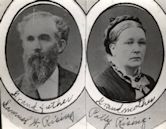 The last site visit I made was to the Rising City Library with Devra in 2013. Library board members showed us photographs of businesses on Main Street, the depot, church, post office, a major fire, and portraits including this one of founders Samuel W. Rising and Polly Rising . They generously allowed us to bring the photographs, some of which were framed and on display in the library, back to the Library Commission for scanning. Lori was able to scan the framed photographs without removing them from their frames.
The last site visit I made was to the Rising City Library with Devra in 2013. Library board members showed us photographs of businesses on Main Street, the depot, church, post office, a major fire, and portraits including this one of founders Samuel W. Rising and Polly Rising . They generously allowed us to bring the photographs, some of which were framed and on display in the library, back to the Library Commission for scanning. Lori was able to scan the framed photographs without removing them from their frames.
Visiting museums, libraries and archives has been a wonderful way to find out more about Nebraska’s history. It’s been great fun. As Bob Hope and Shirley Ross sang in 1938, Thanks for the Memory !
Nebraska Memories is a cooperative project to digitize Nebraska-related historical and cultural heritage materials and make them available to researchers of all ages via the Internet. Nebraska Memories is brought to you by the Nebraska Library Commission. If your institution is interested in participating in Nebraska Memories, see http://nlc.nebraska.gov/nebraskamemories/participation.aspx for more information, or contact Devra Dragos, Technology & Access Services Director.
Posted in General, Nebraska Memories, Preservation
1 Comment
If Pinterest Existed…
The popular website Pinterest describes itself as a “visual discovery tool”. Nebraska Memories also allows for discovery based on visual resources.
Can you imagine what it would be like if Pinterest existed when some of these photographs were taken? I took a moment to let my imagination roam and come up with some Pinterest-esque caption for these great images. Once I got going, I discovered that Nebraska Memories hits several of the major categories you will find on Pinterest today: parties, food, fashion, kids, décor, and of course, cats!

Just like an image on Pinterest can lead you to a great recipe or DIY project, an image in Nebraska Memories can lead you to an interesting story about Nebraska’s past. Visit Nebraska Memories to search for or browse through many more historical images digitized from photographs, negatives, postcards, maps, lantern slides, books and other materials.
Nebraska Memories is a cooperative project to digitize Nebraska-related historical and cultural heritage materials and make them available to researchers of all ages via the Internet. Nebraska Memories is brought to you by the Nebraska Library Commission. If your institution is interested in participating in Nebraska Memories, see http://nlc.nebraska.gov/nebraskamemories/participation.aspx for more information, or contact Beth Goble, Historical Services Librarian, or Devra Dragos, Technology & Access Services Director.
Posted in Nebraska Memories
Leave a comment
Throwback Thursday: Carnegie Library in Havelock, Nebraska built in 1907
Carnegie Library in Havelock, Nebraska built in 1907. Havelock has been incorporated into Lincoln and is located on the Northeast side of town. The library is no longer in existence.
Posted in General, Nebraska Memories
Leave a comment
Nebraska Memories: A Collection of Collections
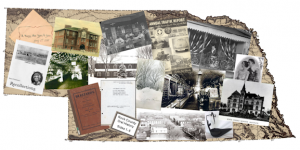 Did you know that Nebraska Memories is a collection of Nebraska cultural heritage collections? When you visit Nebraska Memories, instead of searching for a particular item or person, try clicking on “View Collections.” As a result, you will find Nebraska historical collections from (almost) A-Z. The histories of Nebraska hospitals, cities, towns, counties, public schools, colleges, libraries, musicians, authors, sports and historical events are all represented in the collections found in Nebraska Memories.
Did you know that Nebraska Memories is a collection of Nebraska cultural heritage collections? When you visit Nebraska Memories, instead of searching for a particular item or person, try clicking on “View Collections.” As a result, you will find Nebraska historical collections from (almost) A-Z. The histories of Nebraska hospitals, cities, towns, counties, public schools, colleges, libraries, musicians, authors, sports and historical events are all represented in the collections found in Nebraska Memories.
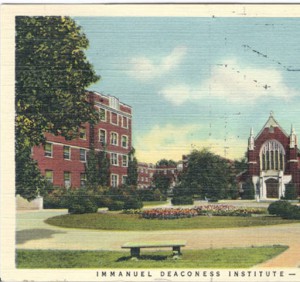 For example, the first collection listed is the Alegent Health Immanuel Medical Center. The rich and well documented history of Immanuel Medical Center in Omaha, Nebraska is shown in the images of the early buildings, people and artifacts. The archive of thousands of photos, papers and items has been maintained for over 120 years, carefully stored and currently housed at the Alegent Health Immanuel Medical Center campus.
For example, the first collection listed is the Alegent Health Immanuel Medical Center. The rich and well documented history of Immanuel Medical Center in Omaha, Nebraska is shown in the images of the early buildings, people and artifacts. The archive of thousands of photos, papers and items has been maintained for over 120 years, carefully stored and currently housed at the Alegent Health Immanuel Medical Center campus.
Other collections in Nebraska Memories include city and county historical societies, such as the Crawford, Fairmont/Filmore County, Hastings, Antelope County, Butler County, and Phelps County, to name a few.
Historical materials related to the Lincoln Public Schools have been collected and saved in some form in various offices, library sites, and schools since the inception of the first school in Lancaster county. Over the years, LPS Library Media Services has made great progress in collecting, preserving, and archiving the history of LPS for the staff and the public.
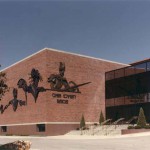 There are other unique collections in Nebraska Memories as well: the Omaha Community Playhouse (pictured right), that includes digitized images of the Playhouse and some of its performances; the Lincoln Police Department, that includes digitized images of police officers from 1885-1907; the Durham Museum in Omaha, with the William Wentworth Collection that consists of 4663 negatives of images that document life in Omaha, Nebraska from 1934 through 1950; and the Bess Streeter Aldrich House and Museum in Elmwood, Nebraska (pictured below), images of which have been selected to give the viewer a deeper understanding of the influences and inspirations that Bess Streeter Aldrich drew upon when writing the 1928 novel “A Lantern in Her Hand.
There are other unique collections in Nebraska Memories as well: the Omaha Community Playhouse (pictured right), that includes digitized images of the Playhouse and some of its performances; the Lincoln Police Department, that includes digitized images of police officers from 1885-1907; the Durham Museum in Omaha, with the William Wentworth Collection that consists of 4663 negatives of images that document life in Omaha, Nebraska from 1934 through 1950; and the Bess Streeter Aldrich House and Museum in Elmwood, Nebraska (pictured below), images of which have been selected to give the viewer a deeper understanding of the influences and inspirations that Bess Streeter Aldrich drew upon when writing the 1928 novel “A Lantern in Her Hand.
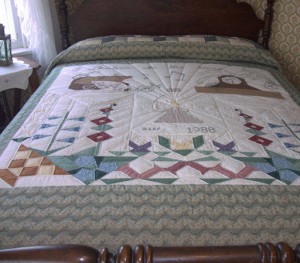 Visit Nebraska Memories to search for or browse through many more historical images digitized from photographs, negatives, postcards, maps, lantern slides, books and other materials.
Visit Nebraska Memories to search for or browse through many more historical images digitized from photographs, negatives, postcards, maps, lantern slides, books and other materials.
Nebraska Memories is a cooperative project to digitize Nebraska-related historical and cultural heritage materials and make them available to researchers of all ages via the Internet. Nebraska Memories is brought to you by the Nebraska Library Commission. If your institution is interested in participating in Nebraska Memories, see Introduction to Participating in Nebraska Memories for more information, or contact Beth Goble, Historical Projects Librarian, or Devra Dragos, Technology & Access Services Director.
Throwback Thursday: Children’s room, Kearney Carnegie Library
Posted in General, Nebraska Memories
Leave a comment
What did it really look like?
It seems like every few weeks a news story about a photo of a model or celebrity being retouched makes the rounds. The topic of photo manipulation or retouching is not new but did you realize that the manipulation of images has been going on since the 1800’s? I don’t know a lot about how this early manipulation was done but they used many techniques including hand-coloring black and white photos and negatives and combining pieces of multiple pictures and negatives to create a new image.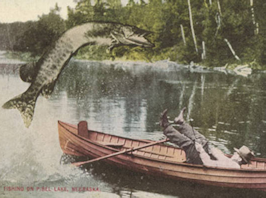 What I do know is that there are many great examples of postcards in Nebraska Memories that feature images that have been manipulated.
What I do know is that there are many great examples of postcards in Nebraska Memories that feature images that have been manipulated.
Let’s start by looking at an obvious manipulation. This postcard is captioned “Fishing on Pibel Lake, Nebraska”. Look at the size of that fish. It is almost as big as the boat. If you want to try catching a big a fish like that you can visit Pibel Lake as it is a Nebraska State Recreation Area. (Update – The Pibel Lake Recreation Area is now owned by the Lower Loup Natural Resources District)
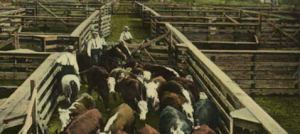 Looking at this postcard captioned “Among the cattle pens, stock yards, South Omaha, Neb.” you can see that color has been added but I think they got something wrong. Have you ever seen healthy green vegetation growing in an active stockyard? Growing up I drove past these stockyards many times. I don’t remember them ever being this lush and green looking when they were filled with cattle.
Looking at this postcard captioned “Among the cattle pens, stock yards, South Omaha, Neb.” you can see that color has been added but I think they got something wrong. Have you ever seen healthy green vegetation growing in an active stockyard? Growing up I drove past these stockyards many times. I don’t remember them ever being this lush and green looking when they were filled with cattle.
Sometimes looking at a single postcard you may realize that color has been added unless you can compare it to the original black and white image or you notice something odd you may think the coloring looks good. It would be fun if we could compare the original image to the enhanced version but unfortunately we don’t have that option. In Nebraska Memories we do however have multiple postcards of the same scenes.
There are two postcards in Nebraska Memories captioned “Partial view of stock yards, South Omaha”. One is black and white while the other one has had color added. Looking at these postcards is a great way to see how adding color changes an image.
These next two postcards appear to be created from the exact same image however the manipulation that was done to them is slightly different. The postcards are captioned Stock pens, South Omaha, Neb. and Stock pens, south side, Omaha, Neb.. Some of the differences between these two postcards are obvious such as making the roofs have a reddish cast to them. Also the postcard on the top has an overcall darker feel to it. 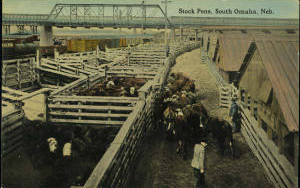
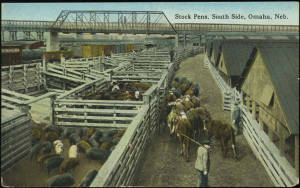 To see these next differences you may need use to above links to look at the actual items in Nebraska Memories where you will be able to zoom in on the postcards. Starting at the bottom left on the postcards do you see the animals in the pen? On one postcard they clearly look like pigs while on the other they look like black blobs. Moving to the right do you see the man standing behind the cattle? On the postcard with the pigs that you can see you will notice that the man is carrying some type of stick over his shoulder while on the other postcard the stick has been colored black and it blends in with the cattle. Next follow the fencing until you locate the man standing on top of the fence. Do you see that there is a tall object next to the man that has been removed from one of the postcards? The last differences I want to point out are the color of the taller fence posts next to the train cars. On one postcard the tops of the posts were left white while the train cars around them were colored. On the other card the posts were colored to match the train cars.
To see these next differences you may need use to above links to look at the actual items in Nebraska Memories where you will be able to zoom in on the postcards. Starting at the bottom left on the postcards do you see the animals in the pen? On one postcard they clearly look like pigs while on the other they look like black blobs. Moving to the right do you see the man standing behind the cattle? On the postcard with the pigs that you can see you will notice that the man is carrying some type of stick over his shoulder while on the other postcard the stick has been colored black and it blends in with the cattle. Next follow the fencing until you locate the man standing on top of the fence. Do you see that there is a tall object next to the man that has been removed from one of the postcards? The last differences I want to point out are the color of the taller fence posts next to the train cars. On one postcard the tops of the posts were left white while the train cars around them were colored. On the other card the posts were colored to match the train cars.
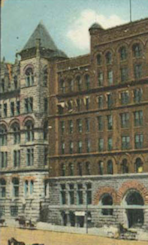 Finally I want to highlight a selection of postcards picturing the Old City Hall and Bee Building. The Old City Hall building was located on the northeast corner 18th & Farnam Streets. The Bee Buidling stood next to it. Both buildings were torn down in 1966 to make way from the Woodmen Tower. Shown here are just a few of the postcards in Nebraska Memories that feature both of these buildings. After looking at all of these postcards I wonder what these buildings really looked like. Because these buildings were not torn down until early in 1966 I would think that there is a color photo of one or both of these buildings available someplace. If you have a color photo of either of these building stashed away or you know where I can see a color photo I would love to see them!
Finally I want to highlight a selection of postcards picturing the Old City Hall and Bee Building. The Old City Hall building was located on the northeast corner 18th & Farnam Streets. The Bee Buidling stood next to it. Both buildings were torn down in 1966 to make way from the Woodmen Tower. Shown here are just a few of the postcards in Nebraska Memories that feature both of these buildings. After looking at all of these postcards I wonder what these buildings really looked like. Because these buildings were not torn down until early in 1966 I would think that there is a color photo of one or both of these buildings available someplace. If you have a color photo of either of these building stashed away or you know where I can see a color photo I would love to see them!
Visit Nebraska Memories to search for or browse through many more historical images digitized from photographs, negatives, postcards, maps, lantern slides, books and other materials.
Nebraska Memories is a cooperative project to digitize Nebraska-related historical and cultural heritage materials and make them available to researchers of all ages via the Internet. Nebraska Memories is brought to you by the Nebraska Library Commission. If your institution is interested in participating in Nebraska Memories, see http://nlc.nebraska.gov/nebraskamemories/participation.aspx for more information, or contact Beth Goble, Historical Projects Librarian, or Devra Dragos, Technology & Access Services Director.
Posted in General, Information Resources, Nebraska Memories, Technology
2 Comments
Baby, It’s Cold Outside
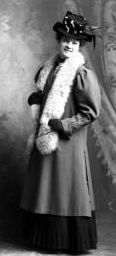 The temperatures have been up and down this winter, to the extreme at either end, but only a couple of longstanding records have been broken. When many of the original temperature records were set, people didn’t have the wide-range of clothing material options that we d
The temperatures have been up and down this winter, to the extreme at either end, but only a couple of longstanding records have been broken. When many of the original temperature records were set, people didn’t have the wide-range of clothing material options that we d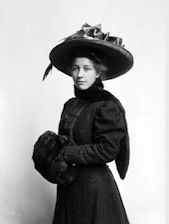 o today. Wool was one of the most common materials used for coats. We assume the coat Miss Tony Smith, in the picture at the left, is wearing was made from wool (Butler County Gallery, 1908). With fashionable puff sleeves, the hem ends about a foot above her floor-length skirt, presumably to keep it out of the wet snow and mud. On some cold mornings I would appreciate those long skirts and multiple petticoats for added warmth. It appears that the scarf around her neck is a fur of some sort. For the middle-class, fur was another material used for warm apparel such as the muff held by Maude Zeilinger in the photo to the right (Butler County Gallery, 1909) .
o today. Wool was one of the most common materials used for coats. We assume the coat Miss Tony Smith, in the picture at the left, is wearing was made from wool (Butler County Gallery, 1908). With fashionable puff sleeves, the hem ends about a foot above her floor-length skirt, presumably to keep it out of the wet snow and mud. On some cold mornings I would appreciate those long skirts and multiple petticoats for added warmth. It appears that the scarf around her neck is a fur of some sort. For the middle-class, fur was another material used for warm apparel such as the muff held by Maude Zeilinger in the photo to the right (Butler County Gallery, 1909) .
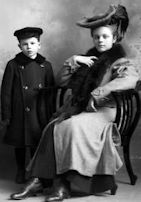
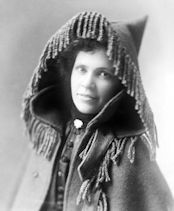 Children wore garments similar to that of adults. The teenage girl seated in the picture to the left wears also wears a wool coat almost the length of long skirts and a fur scarf around her neck. Her brother wears a coat and hat that may have been fashioned after a sailor’s outfit–the wool coat is double-breasted with two rows of large buttons, and his hat is a flat cap (C.E. McNeal family, Butler County Gallery, 1906). While the two ladies and the teenage girl all wear fancy hats, Christie Otoupalik, pictured at the left, would appear to have an advantage against the cold wind with her hooded wool coat (Butler County Gallery, 1902).
Children wore garments similar to that of adults. The teenage girl seated in the picture to the left wears also wears a wool coat almost the length of long skirts and a fur scarf around her neck. Her brother wears a coat and hat that may have been fashioned after a sailor’s outfit–the wool coat is double-breasted with two rows of large buttons, and his hat is a flat cap (C.E. McNeal family, Butler County Gallery, 1906). While the two ladies and the teenage girl all wear fancy hats, Christie Otoupalik, pictured at the left, would appear to have an advantage against the cold wind with her hooded wool coat (Butler County Gallery, 1902).
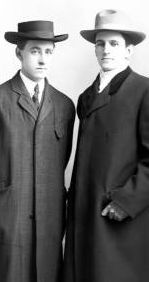
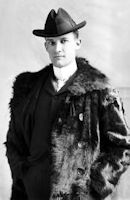 Men also wore warm weather apparal made of various materials. Friends Matt Cram and John Ayers wear long cloth overcoats in their studio portrait on the left (Butler County Gallery, 1907), while Jay Rising of Rising City, in the photograph on the right, wears a coat made from some type of fur or perhaps buffalo hide (Rising City Library Collection, 1902). A couple of decades later the rage would include racoon fur coats for the fashionably dressed young folks about town. While today there is a definite taboo against wearing real animal skins and fur, they have been used since the age of cavemen for clothing and other household goods.
Men also wore warm weather apparal made of various materials. Friends Matt Cram and John Ayers wear long cloth overcoats in their studio portrait on the left (Butler County Gallery, 1907), while Jay Rising of Rising City, in the photograph on the right, wears a coat made from some type of fur or perhaps buffalo hide (Rising City Library Collection, 1902). A couple of decades later the rage would include racoon fur coats for the fashionably dressed young folks about town. While today there is a definite taboo against wearing real animal skins and fur, they have been used since the age of cavemen for clothing and other household goods.
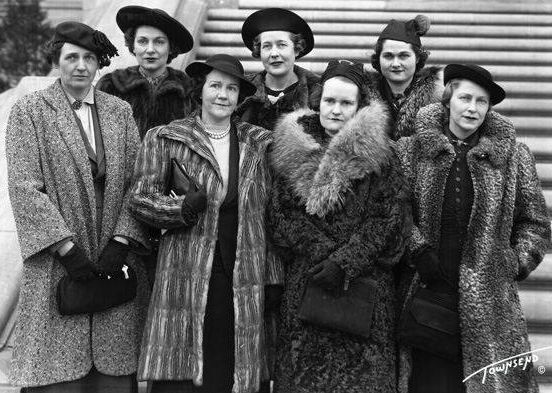 The trend for fur coats continued on for several decades. Although no longer of racoon, several of the ladies who were part of the Fine Arts Association Committee in Lincoln, wear full coats made of various types of fur (Townsend Studio Collection, 1938.)
The trend for fur coats continued on for several decades. Although no longer of racoon, several of the ladies who were part of the Fine Arts Association Committee in Lincoln, wear full coats made of various types of fur (Townsend Studio Collection, 1938.)
Visit Nebraska Memories to search for or browse through many more historical images digitized from photographs, negatives, postcards, maps, lantern slides, books and other materials.
Nebraska Memories is a cooperative project to digitize Nebraska-related historical and cultural heritage materials and make them available to researchers of all ages via the Internet. Nebraska Memories is brought to you by the Nebraska Library Commission. If your institution is interested in participating in Nebraska Memories, see http://nlc.nebraska.gov/nebraskamemories/participation.aspx for more information, or contact Beth Goble, Historical Services Librarian, or Devra Dragos, Technology & Access Services Director.
Posted in Nebraska Memories
Leave a comment
Privileges and Responsibilities
In February and March many Nebraskans like to go to the State Capitol to testify or talk with their senators about bills they support or oppose. This week I will be attending the Nebraska League of Women Voters/American Association of University Women legislative day. The Nebraska Library Association Advocacy Day is in March. As a naturalized citizen I consider voting a privilege and a responsibility, and February is a good time to be reminded of the struggle to extend those rights to every citizen. Susan B. Anthony, anti-slavery campaigner and champion of women’s voting rights, was born February 15th, 1820. In 1878 she and Elizabeth Cady Stanton presented the U.S. Congress with wording for the 19th amendment to the Constitution, ratified 24 years later on August 20, 1920. “The right of citizens of the United States to vote shall not be denied or abridged by the Unites States or by any State on account of sex”.
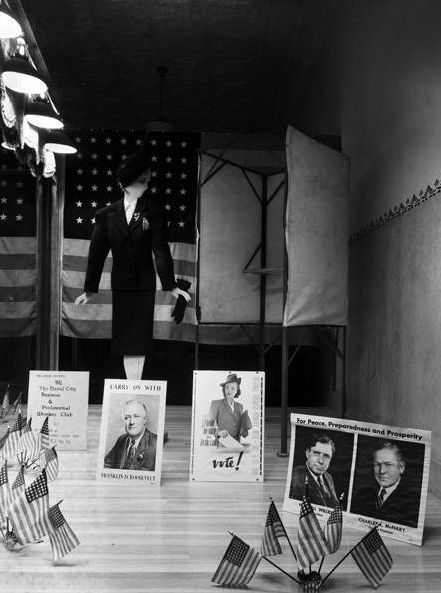 Nebraska Memories includes several images related to voting and elections. This Butler County Gallery photo taken October 1940 shows a window display by the David City Business and Professional Womens Club. It supports Franklin Roosevelt’s campaign. A photograph of a professionally dressed woman bears the caption “Business women in a democracy vote!”
Nebraska Memories includes several images related to voting and elections. This Butler County Gallery photo taken October 1940 shows a window display by the David City Business and Professional Womens Club. It supports Franklin Roosevelt’s campaign. A photograph of a professionally dressed woman bears the caption “Business women in a democracy vote!”
A program from the Polley Music Library collection also celebrates women’s right to vote. 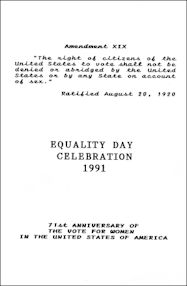 On August 24, 1991 an Equality Day Celebration was held in Lincoln to celebrate the 71st anniversary of the 19th Amendment. It was sponsored by the Women’s Information Network of Lincoln and the Nebraska Commission on the Status of Women. Senator LaVonne Crosby and former Senator Shirley Marsh attended . The afternoon included music, an art display, and Marlene Snyder impersonating suffragist leader Clara Colby. I remember it as a great event!
On August 24, 1991 an Equality Day Celebration was held in Lincoln to celebrate the 71st anniversary of the 19th Amendment. It was sponsored by the Women’s Information Network of Lincoln and the Nebraska Commission on the Status of Women. Senator LaVonne Crosby and former Senator Shirley Marsh attended . The afternoon included music, an art display, and Marlene Snyder impersonating suffragist leader Clara Colby. I remember it as a great event! 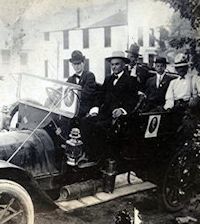
Nebraska Memories also includes some photographs of election campaigning in Nebraska. This photo from the Crawford Historical Society and Musuem collection is particularly interesting. Several men involved with the 1910 Jim Dahlman Campaign for Governor sit in a Franklin touring car. Mr. Dahlman did not win the race. Apparently Doc Middleton was a supporter. Maybe that’s the reason he lost! Doc is in the back seat on the left side in the photograph, wearing a tall hat. Visit Nebraska Memories to search for or browse through many more historical images digitized from photographs, negatives, postcards, maps, lantern slides, books and other materials.
Nebraska Memories is a cooperative project to digitize Nebraska-related historical and cultural heritage materials and make them available to researchers of all ages via the Internet. Nebraska Memories is brought to you by the Nebraska Library Commission. If your institution is interested in participating in Nebraska Memories, see http://nlc.nebraska.gov/nebraskamemories/participation.aspx for more information, or contact Beth Goble, Historical Services Librarian, or Devra Dragos, Technology & Access Services Director.
Posted in General, Nebraska Memories
Leave a comment
A Cup of Tea
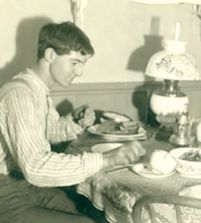 We are having balmy January days here in Nebraska, but people in colder parts of the country may be glad to know that January is National Hot Tea Month. While there are only a few days left in the month, a hot cup of tea is always a good way to ward off the winter chill. A look through Nebraska Memories reveals that tea has been a part of people’s lives for many years.
We are having balmy January days here in Nebraska, but people in colder parts of the country may be glad to know that January is National Hot Tea Month. While there are only a few days left in the month, a hot cup of tea is always a good way to ward off the winter chill. A look through Nebraska Memories reveals that tea has been a part of people’s lives for many years.
Tea cups are featured on this Fremont family’s table as they gather in their kitchen for a meal. Photographs from the William Wallace residence in Omaha show a tea kettle in the kitchen and silver tea sets 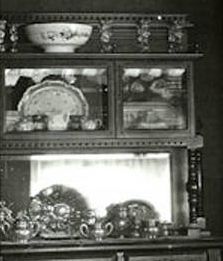 in the dining room and parlor.
in the dining room and parlor.
Although there may not have been actual tea involved, in my opinion, some of the sweetest tea-related pictures in Nebraska Memories are the images of children having tea parties. There are several posed portraits of children with tea sets in the Butler County Gallery collection, including this photograph of Dorothy Rich sitting with a doll and a stuffed bunny. The 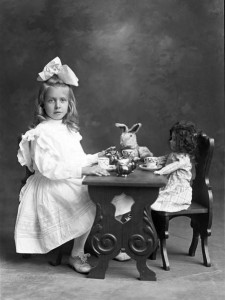 Nebraska State Historical Society collection includes a less formal image of children playing with a tea set in a barn.
Nebraska State Historical Society collection includes a less formal image of children playing with a tea set in a barn.
Visit Nebraska Memories to search for or browse through many more historical images digitized from photographs, negatives, postcards, maps, lantern slides, books and other materials.
Nebraska Memories is a cooperative project to digitize Nebraska-related historical and cultural heritage materials and make them available to researchers of all ages via the Internet. Nebraska Memories is brought to you by the Nebraska Library Commission. If your institution is interested in participating in Nebraska Memories, see http://nlc.nebraska.gov/nebraskamemories/participation.aspx for more information, or contact Beth Goble, Historical Services Librarian, or Devra Dragos, Technology & Access Services Director.
Posted in Nebraska Memories
Leave a comment
Throwback Thursday: Children from School District 62 selecting books from the bookmobile, circa 1930’s
Nebraska Public Library Commission bookmobile delivering books to school district 62 children, circa 1930’s
Posted in Books & Reading, General, Nebraska Memories
Leave a comment
A Balloon School in Nebraska?
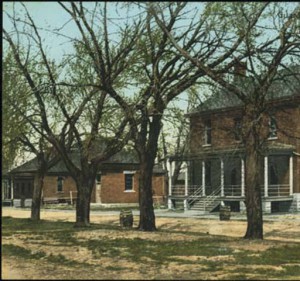 While I was in Rochester, New York this past Christmas visiting my husband’s family, my father-in-law showed me some letters from a World War I 2nd Lieutenant from Spencerport, NY, who had a Nebraska connection. Based on the letters and some further research, I found out that this young man was stationed at Fort Omaha, Nebraska for Balloon School.
While I was in Rochester, New York this past Christmas visiting my husband’s family, my father-in-law showed me some letters from a World War I 2nd Lieutenant from Spencerport, NY, who had a Nebraska connection. Based on the letters and some further research, I found out that this young man was stationed at Fort Omaha, Nebraska for Balloon School.
Fort Omaha (the Nebraska Memories picture to the left), located at 5730 North 30th Street, in Omaha, Nebraska, was opened in 1868 as an Indian War-era United States Army supply depot for various forts along the Platte River. This is also where Ponca Chief Standing Bear and 29 fellow Ponca were held prior to the landmark 1879 trial of Standing Bear v. Crook. Judge Elmer Dundy determined that American Indians were persons within the meaning of the law and that the Ponca were illegally detained after leaving Indian Territory in January 1879. 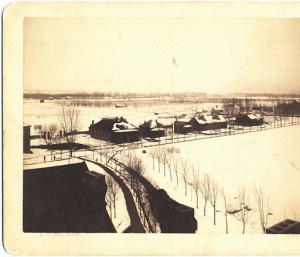 The Nebraska Memories picture of the fort to the right, was taken about that same time period.
The Nebraska Memories picture of the fort to the right, was taken about that same time period.
Fort Omaha today is primarily occupied by Metropolitan Community College, but continues to house Navy, Marine and Army Reserve units. The fort is located in the present-day Miller Park neighborhood of North Omaha. The Fort Omaha Historic District is listed on the National Register of Historic Places. The district includes the 1879 General Crook House Museum, as well as the 1879 Quartermaster’s office, 1878 commissary, 1884 guardhouse, 1883 ordnance magazine and 1887 mule stables.
In 1907 the Army built a large steel hangar at Fort Omaha for use in experiments with dirigibles, a program that was abandoned in 1909. This program and its successor, the military use of hot air balloons for reconnaissance missions, were part of the American Expeditionary Forces. A balloon house was built in 1908, and in 1909 the first balloon flight took place. Here is a picture from Nebraska Memories of the Balloon House at Fort Omaha, taken sometime between 1908 and 1910:
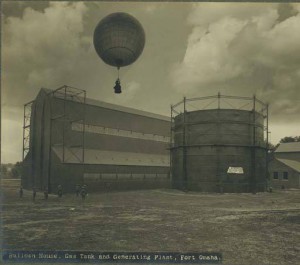 Shortly after the United States entered World War I, 800 men enlisted in the Aviation Section, U.S. Signal Corp, one of whom was William Spencer Barker, from Spencerport, NY. They were immediately sent to the Balloon School at Fort Omaha for training. More than 16,000 airmen went through the Balloon Schools at Fort Omaha and other locations around the U.S., between 1908 and the close of the program in 1919.
Shortly after the United States entered World War I, 800 men enlisted in the Aviation Section, U.S. Signal Corp, one of whom was William Spencer Barker, from Spencerport, NY. They were immediately sent to the Balloon School at Fort Omaha for training. More than 16,000 airmen went through the Balloon Schools at Fort Omaha and other locations around the U.S., between 1908 and the close of the program in 1919.
Balloonists were trained in map reading and charting troop movements. This information was communicated through an extensive switchboard system to artillery troops on the ground. The balloons were “captive” stationary balloons, utilized tail fins for stabilization, and had cables to tether the balloon to the ground.
In 1917, 2nd Lieutenant Baker was part of the 5th Squadron, Balloon Division, and did see military action with balloon squadrons in France from 1918-1919.
Visit Nebraska Memories to search for or browse through many more historical images of digitized from photographs, negatives, postcards, maps, lantern slides, books and other materials.
Nebraska Memories is a cooperative project to digitize Nebraska-related historical and cultural heritage materials and make them available to researchers of all ages via the Internet. Nebraska Memories is brought to you by the Nebraska Library Commission. If your institution is interested in participating in Nebraska Memories, see http://nlc.nebraska.gov/nebraskamemories/participation.aspx for more information, or contact Beth Goble, Historical Services Librarian, or Devra Dragos, Technology & Access Services Director.
Throwback Thursday: Children get books at the Nebraska Public Library Commission Bookmobile, circa 1930’s
Children from School District 32 visit the Nebraska Public Library Commission Bookmobile, circa 1930’s.
Posted in Books & Reading, General, Nebraska Memories
Leave a comment
Thanks for your help!
 You may remember earlier this year we asked for help in transcribing two autograph albums in Nebraska Memories that belonged to May Martin Ellis and her husband John Ellis. The project was a great success and it only took one week for both albums to be transcribed. We want to thank everyone who helped make this project a success.
You may remember earlier this year we asked for help in transcribing two autograph albums in Nebraska Memories that belonged to May Martin Ellis and her husband John Ellis. The project was a great success and it only took one week for both albums to be transcribed. We want to thank everyone who helped make this project a success.
For those of you not familiar with the project these albums contain many pages of handwritten inscriptions. Some are easy to read while  others take a bit more effort to decipher. Transcribing the handwriting makes it easier to read the inscriptions and makes the albums searchable. As you read the transcriptions remember we did our best to type the text as it was written and did not fix any of errors. This means you will find phrases such as “always paddle your one cenue” and “In the depth of thine- Effeetiend[?] , please plant a sweat Fore-get me not.” The question mark in the brackets means that we were unable to clearly read the handwriting and typed our best guess. If you are have having a hard time deciphering those phrases my guess is that they meant to say “always paddle your own canoe” and “In the depth of thine affection plant a sweet forget me not”.
others take a bit more effort to decipher. Transcribing the handwriting makes it easier to read the inscriptions and makes the albums searchable. As you read the transcriptions remember we did our best to type the text as it was written and did not fix any of errors. This means you will find phrases such as “always paddle your one cenue” and “In the depth of thine- Effeetiend[?] , please plant a sweat Fore-get me not.” The question mark in the brackets means that we were unable to clearly read the handwriting and typed our best guess. If you are have having a hard time deciphering those phrases my guess is that they meant to say “always paddle your own canoe” and “In the depth of thine affection plant a sweet forget me not”.
The transcriptions available in Nebraska Memories can be viewed in three different places in the interface. While I’m focusing on these two albums the viewing options apply to all items in the collection that include transcriptions. Let me show you how you can search and view the transcribed text.
While working with these albums I remember reading at least one reference to dishes that I found amusing but unfortunately I don’t know which album it was in. A search for the word dishes shows that the word appears in both albums. I am going to look at May’s album. When I click on the link to her album from the search results page I’m taken directly to page 42 in the album where Eva has written a note to May about washing dishes.
 As I mentioned there are three places where the transcription can be viewed. The first place is towards the bottom of the page in the area labeled Description. The second place is on the Text tab. This tab is located just above the album page between the Image tab and the search box.
As I mentioned there are three places where the transcription can be viewed. The first place is towards the bottom of the page in the area labeled Description. The second place is on the Text tab. This tab is located just above the album page between the Image tab and the search box. 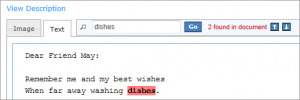 These two tabs can be used to switch between the Image view and Text (transcript) view of the page. After clicking on the Text tab you will see the word dishes highlighted. Also note when you are on the Text tab that up and down arrows now appear next to the phrase “2 found in document”. Use these arrows to move to the previous and next instances of your search term.
These two tabs can be used to switch between the Image view and Text (transcript) view of the page. After clicking on the Text tab you will see the word dishes highlighted. Also note when you are on the Text tab that up and down arrows now appear next to the phrase “2 found in document”. Use these arrows to move to the previous and next instances of your search term.
 The last way to view the transcription is by clicking on the View Image & Text link. This view allows you to see the transcribed text and the image at the same time. To adjust the widths of the text and image area click on the slider button and drag it left or right. Use the thumbnails at the bottom of the page to move from page to page.
The last way to view the transcription is by clicking on the View Image & Text link. This view allows you to see the transcribed text and the image at the same time. To adjust the widths of the text and image area click on the slider button and drag it left or right. Use the thumbnails at the bottom of the page to move from page to page.
As the New Year begins I hope you take a few minutes to explore these albums and all of the digitized photographs, negatives, postcards, maps, lantern slides, books and other materials available through Nebraska Memories.
Nebraska Memories is a cooperative project to digitize Nebraska-related historical and cultural heritage materials and make them available to researchers of all ages via the Internet. Nebraska Memories is brought to you by the Nebraska Library Commission. If your institution is interested in participating in Nebraska Memories, see http://nlc.nebraska.gov/nebraskamemories/participation.aspx for more information, or contact Beth Goble, Historical Projects Librarian, or Devra Dragos, Technology & Access Services Director.
Home, Sweet Home, Part II
Be it ever so humble … The interiors of early Nebraskans’ homes varied as much as the exteriors. Sod houses may have had only one room, and tenement houses may have had shared public areas, but there were mansions, too, containing extras like formal entry halls, libraries, smoking rooms, conservatories, sun rooms, and billiards rooms.
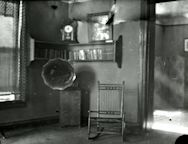 The image at left shows a sparsely finished room in an early 1900s Omaha settlement house which still provided a corner for relaxing in a rocking chair to read a book from the
The image at left shows a sparsely finished room in an early 1900s Omaha settlement house which still provided a corner for relaxing in a rocking chair to read a book from the 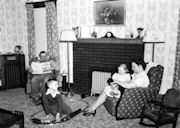 shelf while listening to music on the gramophone (Gramophone and chair inside settlement house, Omaha Public Library Collection). About four decades later, the descendants of those immigrants would have had a living room more similar to the one at the right (John Birkel family, Butler County Gallery Collection). While basics furnishings are the same and the room is used for reading, relaxing and listening to music, the easy chairs are now upholstered and the floor carpeted while the music comes from the radio at the left. Note that in the settlement house a clock and picture sit on top of the book shelf, while in the later living room a clock sits on the fireplace mantel with a picture hanging above.
shelf while listening to music on the gramophone (Gramophone and chair inside settlement house, Omaha Public Library Collection). About four decades later, the descendants of those immigrants would have had a living room more similar to the one at the right (John Birkel family, Butler County Gallery Collection). While basics furnishings are the same and the room is used for reading, relaxing and listening to music, the easy chairs are now upholstered and the floor carpeted while the music comes from the radio at the left. Note that in the settlement house a clock and picture sit on top of the book shelf, while in the later living room a clock sits on the fireplace mantel with a picture hanging above.
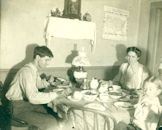 In a simple house or farm house, meals were most likely served in the kitchen as is the case in the phot
In a simple house or farm house, meals were most likely served in the kitchen as is the case in the phot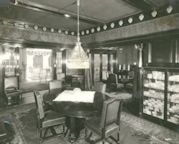 ograph to the left (Kitchen dining, Keene Memorial Library Collection). In the better part of town, a fancy house would have had a separate dining room such as the one at right, featuring chandelier lighting, coffered ceiling, carved dining table with matching upholstered chairs, oriental carpet and glass-front cabinet showcasing the fine china (Ray Julius Nye residence dining room, Keene Memorial Library Collection). Still the family in the kitchen looks happy enough.
ograph to the left (Kitchen dining, Keene Memorial Library Collection). In the better part of town, a fancy house would have had a separate dining room such as the one at right, featuring chandelier lighting, coffered ceiling, carved dining table with matching upholstered chairs, oriental carpet and glass-front cabinet showcasing the fine china (Ray Julius Nye residence dining room, Keene Memorial Library Collection). Still the family in the kitchen looks happy enough.
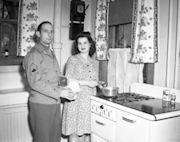 While the woman in the picture above probably cooked her family’s meals on a wood stove and used kerosene in her lamps, the young woman in the picture at right appears to have all the latest appliances available in 1945 (Man and woman in a kitchen, Omaha Public Library Collection). In addition to the gas stove and oven, she has electricity (the fuse box is behind her), indoor plumbing and probably a water heater. All that and a soldier safely returned from the war!
While the woman in the picture above probably cooked her family’s meals on a wood stove and used kerosene in her lamps, the young woman in the picture at right appears to have all the latest appliances available in 1945 (Man and woman in a kitchen, Omaha Public Library Collection). In addition to the gas stove and oven, she has electricity (the fuse box is behind her), indoor plumbing and probably a water heater. All that and a soldier safely returned from the war!
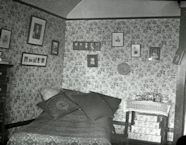
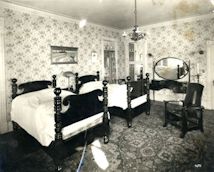 How comfortable do you think the bed at the left would be? It seems to dip a bit in the middle. But then this photograph is of a “third floor bedroom,” so even though the room is nicely furnished with extra pillows on the bed, framed photographs hung from a picture rail and a bedside table, perhaps it was not the “best guest room” (Bed at Wallace residence, Omaha Public Library Collection). In the master bedroom at the right, however, one would think the Mr. and Mrs. slept quite well in their own beds with the carved and turned frames (Ray Julius Nye residence master bedroom, Keene Memorial Public Library Collection).
How comfortable do you think the bed at the left would be? It seems to dip a bit in the middle. But then this photograph is of a “third floor bedroom,” so even though the room is nicely furnished with extra pillows on the bed, framed photographs hung from a picture rail and a bedside table, perhaps it was not the “best guest room” (Bed at Wallace residence, Omaha Public Library Collection). In the master bedroom at the right, however, one would think the Mr. and Mrs. slept quite well in their own beds with the carved and turned frames (Ray Julius Nye residence master bedroom, Keene Memorial Public Library Collection).
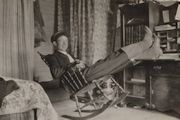 No matter the furnishings or the number or types of rooms, people could still kick back and relax in their own personal space like the gentleman above (Man in rocking chair at desk, Nebraska State Historical Society Collection). Or perhaps enjoy a Christmas party like the children in the picture below with the interesting tree and decorations (Joseph T. May residence Christmas party, Keene Memorial Public Library Collection). We hope your Christmas is as merry as theirs!
No matter the furnishings or the number or types of rooms, people could still kick back and relax in their own personal space like the gentleman above (Man in rocking chair at desk, Nebraska State Historical Society Collection). Or perhaps enjoy a Christmas party like the children in the picture below with the interesting tree and decorations (Joseph T. May residence Christmas party, Keene Memorial Public Library Collection). We hope your Christmas is as merry as theirs!
Nebraska Memories is a cooperative project to digitize Nebraska-related historical and cultural heritage materials and make them available to researchers of all ages via the Internet. Nebraska Memories is brought to you by the Nebraska Library Commission. If your institution is interested in participating in Nebraska Memories, see http://nlc.nebraska.gov/nebraskamemories/participation.aspx for more information, or contact Beth Goble, Historical Services Librarian, or Devra Dragos, Technology & Access Services Director.
Posted in Nebraska Memories
Leave a comment
Throwback Thursday: Nebraska Public Library Commission Bookmobile, circa 1930’s
Children from School District 8 come out to meet the Nebraska Public Library Commission Bookmobile, circa 1930’s.
Posted in Books & Reading, General, Nebraska Memories
Leave a comment
NCompass Live: Nebraska Memories
 Join us for next week’s NCompass Live: “Nebraska Memories”, on Wednesday, December 17, 10:00-11:00 am Central Time.
Join us for next week’s NCompass Live: “Nebraska Memories”, on Wednesday, December 17, 10:00-11:00 am Central Time.
Join Beth Goble, Allana Novotny and Devra Dragos to see what is happening with Nebraska Memories, our cooperative project to digitize Nebraska-related historical and cultural heritage materials. Nebraska Memories has a new interface, several newer collections, and a new policy on the donation of materials from individuals.
Upcoming NCompass Live events:
- December 24 – Installing and Using the OverDrive App: A Day-Before-Christmas Refresher!
- December 31 – Tech Talk with Michael Sauers: WordPress and SEO/SMO
- January 7, 2015 – Extreme Customer Service @ Your Library
For more information, to register for NCompass Live, or to listen to recordings of past events, go to the NCompass Live webpage.
NCompass Live is broadcast live every Wednesday from 10am – 11am Central Time. Convert to your time zone on the Official U.S. Time website. The show is presented online using the GoToWebinar online meeting service. Before you attend a session, please see the NLC Online Sessions webpage for detailed information about GoToWebinar, including system requirements, firewall permissions, and equipment requirements for computer speakers and microphones.
Posted in Education & Training, Nebraska Memories
Leave a comment
